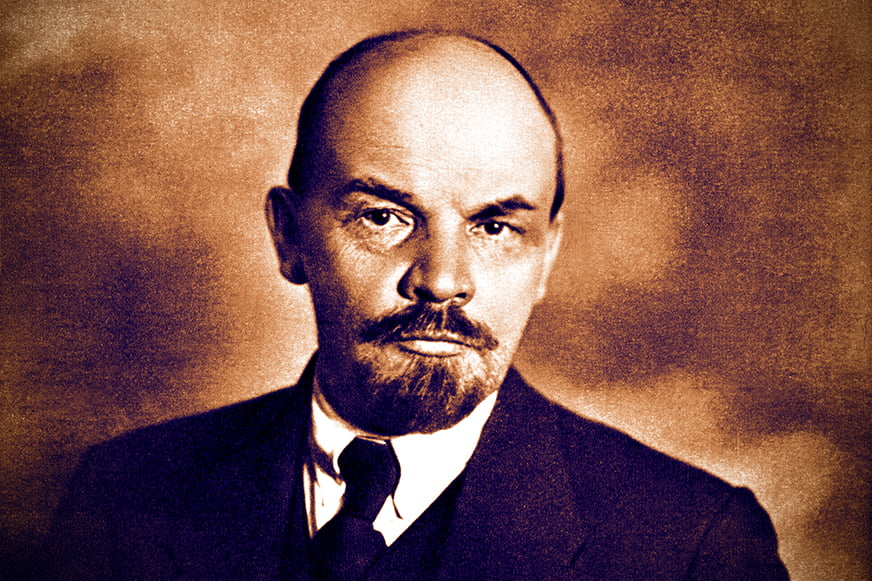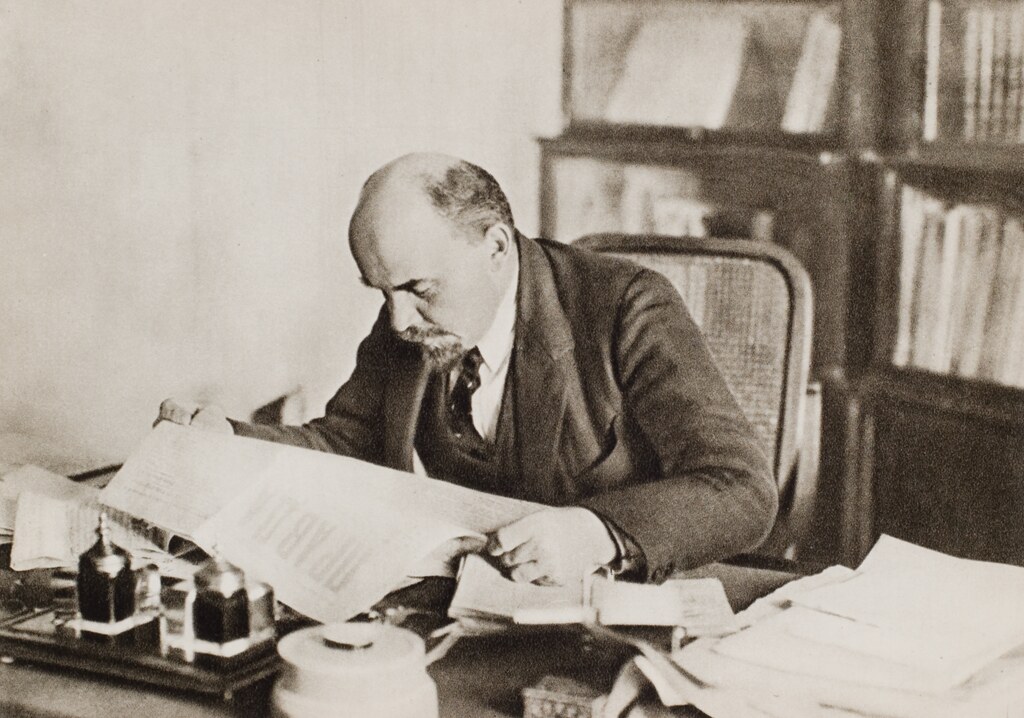After a brief break, we welcome the return of our series, Lenin in a Year, in which we explore the many writings – some more and some less well-known – of history’s greatest revolutionary, V. I. Lenin, in this centenary year of his death.
In our last instalment, Lenin had arrived back in Russia in April 1917. On his arrival, he found the second-rank leaders of the Bolshevik Party confused as to the key tasks of a revolution that was then in full swing. His famous April Theses, which we looked at last time, marked a key turning point in politically rearming the party for the conquest of power.
The events of Lenin’s life up to April 1917 are covered in volume one of In Defence of Lenin by Rob Sewell and Alan Woods. This new biography seeks to reclaim the real legacy of Lenin and Bolshevism from beneath the pile of lies poured on them by bourgeois historians and Stalinists alike. You can get your copy of this invaluable handbook for today’s revolutionaries today from Wellred Books.
This week we take a look at another of Lenin’s key writings, The Tasks of the Proletariat in our Revolution, which developed the ideas contained in the April Theses more fully, but which was not published until the epoch-making year of 1917.
In ‘normal’ times, parties, governments and institutions can appear somewhat fixed. But in revolutionary periods, their rise and fall, the placing on and taking off of new ‘democratic’ and even ‘revolutionary’ costumes, amidst the whirlwind of events and sharp turns in the consciousness of the masses – all this can take the breath away.
Without a grasp of the fundamental processes at play, it is possible even for sincere revolutionaries to lose their heads and become completely disoriented. So it was even with the cadres of the most revolutionary party in history, the Bolshevik Party, in the weeks following the February Revolution of 1917.
Lenin’s political intervention, to rearm the party, was vital, and it was to that end that The Tasks of the Proletariat in our Revolution was written in early April 1917. It was intended to be used at the Bolsheviks’ party congress later that month. A few typed copies were circulated to delegates, and it served an important role in Lenin’s polemic, but it was not published for general circulation until September 1917 due to logistical chaos at the printing press in St. Petersburg. Its key points were published, however, and summed up brilliantly in the famous April Theses.
By late September, when this pamphlet saw the light of day, the same fundamental question that the February Revolution had posed remained unanswered. In February, the reformist Menshevik and SR leaders of the working class handed power back to the representatives of the capitalist class in the so-called Provisional Government after the downfall of the Tsar. This capitalist government was, in turn, tied by its most fundamental interests to both the land-owning aristocracy and to the foreign finance capital of the imperialists. It was therefore unable to resolve the problems of the masses that had led to their revolutionary awakening.
In fact, it had failed to even begin posing the tasks of the February Revolution. As Lenin explained in April: “Up to now this government has not even fixed a date for the convocation of the Constituent Assembly. It is not laying a finger on the landed estates, which form the material foundation of feudal tsarism.” This remained the state of play in September.
Above all, the Provisional Government remained an imperialist government tied by thousands of threads to Anglo-French imperialism. In April, a leaked telegram from the minister of war, Pavel Milyukov, to the French and British ambassadors promising to continue the war was made public. A wave of anger was triggered, and a government crisis followed, which the ruling class tried to smooth over by inviting ‘socialists’ like Kerensky to head up the provisional government.
But this changed nothing fundamental. The government continued to pursue a disastrous war policy. In September 1917, Europe was still embroiled in the slaughter of imperialist trench warfare. Russia’s frontier was suffering losses numbering in their millions. As Lenin stated in the text:
“Russia at present is seething. Millions and tens of millions of people, who had been politically dormant for ten years and politically crushed by the terrible oppression of tsarism and by inhuman toil for the landowners and capitalists, have awakened and taken eagerly to politics.”
Lenin’s assessment in April – of the imperialist character of the Provisional Government, despite its ‘democratic’ language; of the treachery of the petty-bourgeois Menshevik and SR ‘compromisers’ in the Soviets; and of the necessity, therefore, for a new revolution to put the working class in power – was being learned on a mass scale in the months leading up to September and October, through painful experience.
 Lenin’s political intervention, to rearm the party, was vital / Image: public domain
Lenin’s political intervention, to rearm the party, was vital / Image: public domain
The first to grasp the need for a new insurrection were the workers of the two capitals, Petrograd and Moscow. Frustration had begun to boil over in some areas, particularly among the working class and some of the regiments posted near the capital. This was seen in the armed demonstrations of the ‘July Days’ in Petrograd.
Whilst the soviets were created by the urban proletariat, the model was adopted by the rural population too. Relying on the peasantry, the soldiers (who were mostly peasants in uniform), and other petty-bourgeois elements who constituted the vast majority of Russian society, the SRs and the Mensheviks, with their petty-bourgeois outlook, had assumed the majority in the national leadership of the soviets. But these layers too were beginning to draw similar conclusions, albeit with a delay.
By late September, both the Moscow and Petrograd Soviets had elected Bolshevik chairmen. The Bolsheviks had a 60 percent majority and a 90 percent majority respectively. The Petrograd working class were striving for soviet power, for the overthrow of the Provisional Government and the concentration of power in the hands of the working class.
The broader masses were in ferment, although outside Petrograd and Moscow they had not necessarily clearly understood the need for a second revolution. But the Bolsheviks could feel the tide beginning to turn and were pushing for the second all-Russian Congress to be convened as soon as possible. The SRs and the Mensheviks were stalling.
Reading this text, we see how clearly, and how far in advance Lenin had understood that the primary obstacle to the further advance of the revolution was precisely the gap between the class outlook of the leadership of the soviets, and the class nature of the soviets themselves. Only by turning them into organs of proletarian struggle, that is, by winning them to revolutionary Bolshevik leadership, could the road be opened to the October Revolution.
The main tasks identified by Lenin, therefore, were for the Bolsheviks firstly to win over the proletariat to a proletarian revolutionary position, and “cure it” of its “intoxication” with the honeyed phrases of the bourgeois government about “unity”. Secondly, the Bolsheviks, at the head of the proletariat whose confidence they strove to win, had to win over in turn the peasantry to an understanding that only the proletariat in power could solve their most pressing demands (i.e. the expropriation of the land from the big landlords, a constituent assembly, and the ending of the war, etc.)
This could only be achieved by patiently highlighting the revolutionary role of the proletariat, of the need for it to seize power, by exposing the treacherous role of the bourgeoisie, by breaking with the liberals as allies, and by placing demands on the petty-bourgeois leaders of the SRs and Mensheviks to carry out their programme by seizing power for themselves in order precisely to expose them.
“The leaders of the petty bourgeoisie “must” teach the people to trust the bourgeoisie. The proletarians must teach the people to distrust the bourgeoisie.”
By September, this correct policy was bearing its fruit. Having increasingly conquered the masses, the denouement was approaching. Insurrection was posed on the agenda and the time for action had arrived. Again the Bolshevik Party faced a crisis. As Trotsky explained in his masterpiece, The History of the Russian Revolution:
“It might seem as though the April Days had returned – Lenin again in opposition to the Central Committee. The questions stand differently, but the general spirit of his opposition is the same: the Central Committee is too passive, too responsive to social opinion among the intellectual circles, too compromisist in its attitude to the Compromisers. And above all, too indifferent, fatalistic, not attacking à la Bolshevik the problem of the armed insurrection.”
Again, Lenin’s intervention, in which he grasped the fundamental need of the hour, was vital to overcoming the crisis, as it had been when he wrote The Tasks of the Proletariat in our Revolution.
 All serious revolutionaries should read this document thoroughly / Image: public domain
All serious revolutionaries should read this document thoroughly / Image: public domain
The relevance and freshness of this document strike the reader even today. On a world scale, the working class represents a big majority of the population. Revolutionary events are impending: from Sri Lanka to Kenya, we see the foreshocks of the earthquakes to come. And yet, the workers’ organisations are dominated by petty-bourgeois leaders, whose main role is to sow illusions in reformism and who desperately try to smooth over the struggle of the working class and guide it into safe channels – safe, that is, for the bourgeoisie.
Communists today must also use this transitional method, to teach the working class to distrust the bourgeoisie, to expose these petty-bourgeois leaders of the working class’ organisations, and ultimately to replace them with proletarian class fighters.
Another aspect of the document, even more relevant at the time of its publication on the eve of the October Revolution than at the time of writing in April, was the detailed approach Lenin takes to outlining the forms that the workers' state might take, a question that he took up in more detail in his class text, The State and Revolution, which we will look at next week.
The tasks in our revolution, which is approaching on the horizon today, will fundamentally be the same as in Lenin’s day: to prepare the proletariat to break with capitalism and to construct the world socialist order. The ideas outlined in this and Lenin’s many other rich writings provide us with the fundamental method of arming the proletarian vanguard for its historic task.
However, the fundamentals do not give ready-made tactics for every given scenario. All serious revolutionaries should read this document thoroughly, as it gives an insight into the masterful method that Lenin applied, to understand the dynamics of the processes taking place, and to extract the necessary tactics for the moment. This understanding and ability that Lenin had developed were key factors in the success of the October Revolution, which showed the way forward for all of humanity towards a new world, freed of exploiters and oppressors, in which humankind could develop all the potential contained within it.

